Analysis of the Current Status and Hot Technologies of Carbon Dioxide Geological Storage
Abstract
:1. Introduction
2. Data and Method
2.1. Data Sources
2.2. Analysis Method
3. Results and Analysis
3.1. Annual Publications
- (1)
- Initial stage (2000–2005). The number of published articles increased from 5 in 2000 to 37 in 2005, and the annual average of published articles worldwide was less than 18. At that time, the international community only had the United Nations Framework Convention on Climate Change (UNFCCC), which came into force in 1994 and established the ultimate goal of addressing climate change and the basic principles of international cooperation in addressing climate change, and the Kyoto Agreement, promulgated in December 1997, which limited greenhouse gas emissions in the form of laws and regulations. Developed countries began to take on the obligation to reduce carbon emissions in 2005, while developing countries began to take on the obligation to reduce emissions in 2012. It can be seen that the reason for the lack of research results at this stage may be that countries do not pay enough attention to climate change. The corresponding capital investment, technology development, promotion and application, policies and regulations, institutional settings, and information dissemination have become the factors limiting countries’ adaptation to climate change as well as the barriers restricting research on environmental protection.
- (2)
- Rapid growth stage (2006–2013). The annual published articles in this stage show an increasing trend, rising from 62 in 2006 to 497 in 2013. The annual average number of published articles is 199 with an increase rate 11.7 times than that of the initial stage. The increase in research results shows that countries all over the world pay attention to the environmental consequences caused by carbon emissions, and the direct reason is the carbon emission policies issued by countries all over the world. For example, the European Union [38,39] began to implement the new energy policy in 2007. On June 4, The Outline of The National Medium-Long Term Science Technology Development Plan (2006–2020) issued by China [40] lists the “development of efficient, clean and near-zero CO2 emission fossil energy development and utilization technologies” as the key research content in the advanced energy field. The Bali Action Plan, formulated in 2007, adheres to addressing climate change under the framework of sustainable development and puts forward specific targets, ways, and measures for emission reduction. The UK [41,42] introduced laws and regulations related to carbon capture and storage technologies in 2008. The US [43] adopted Clean Energy and Security, which is an incentive system for developing carbon capture and storage technologies. In December 2009, the 15th Conference of the Parties to the United Nations Framework Convention on Climate Change (UNFCCC) proposed a follow-up target requiring developed countries to reduce their emissions by 40% by 2020 compared with the 1990 base year and to achieve zero emissions (at least a 95% reduction) by 2050. The 2015 Paris Agreement sets out arrangements for global action on climate change after 2020 with the long-term goal of keeping the global average temperature rise below 2 degrees Celsius over pre-industrial times and striving to limit the temperature rise to 1.5 degrees Celsius. Australia [44,45] also established special organizations and financial support to develop carbon storage technologies. Within these framework constraints, many countries around the world are developing various carbon reduction regulations to achieve their own goals. In the context of countries actively responding to protect the environment, research results have shown significant growth.
- (3)
- Stable development phase (2014–2021). The growth rate of annual publications in this phase has slowed down, but the number of articles is more stable. This may be because the laws and regulations related to CO2 geological storage, emission reduction, and climate may be more mature, the research incentives in this field are better, and the research results of CO2 geological storage have been implemented to a certain extent. However, under different geographical conditions and resource endowments, there are differences in the path of energy-clean transformation in different countries, so the number of articles has decreased slightly compared with previous years, but the overall trend remains stable.
3.2. Co-Authorship Network
3.2.1. Co-Authorship of Author Analysis
3.2.2. Co-Authorship of Institutions Analysis
3.2.3. Co-Authorship of Countries Analysis
3.3. Co-Occurrence Network of Keywords
3.4. Frontal Analysis
4. Conclusions
- (1)
- Based on the analysis of the research results of carbon dioxide geological storage in the past 20 years (2000–2021), the published papers are divided into three periods: the initial period (2000–2005), the rapid growth period (2006–2013), and the stable development period (2014–2021). Overall, the number of articles on CO2 geological sequestration published by countries around the world is on the rise.
- (2)
- Countries with the richest research achievements are the United States, China, and the United Kingdom through the analysis of research subjects (authors, institutions, and countries). It mainly concentrates on the University of Texas at Austin, Chinese Academy of Sciences, University of Edinburgh, and other institutions. They form cooperative networks with Stefan Bachu and Michael A Celia as the center and radiating to the outside. The contact between authors is limited by region, economy, culture, and other aspects. Moreover, there is little cooperation between eastern and western countries. Most of the cooperation is between the core institutions in some major scientific research countries.
- (3)
- Through the analysis of hot research keywords and research frontiers, we found that the research fields of CO2 geological storage mainly focus on climate, environment, geology, and coal mining, and the research contents mainly focus on rock siting, deep brine CO2 injection, geological storage temperature, porous media, etc., and the research objects mainly focus on waters, oceans and gas convection. Strengthening shale gas recovery and underground storage, pore structure, methane reservoir and methane adsorption will be the future research directions.
Author Contributions
Funding
Data Availability Statement
Conflicts of Interest
References
- INTERNATIONAL ENERGY AGENCY. Global Energy Review: CO2 Emissions in 2021. Available online: https://www.iea.org/reports/global-energy-review-CO2-emissions-in-2021-2 (accessed on 1 March 2022).
- Lau, H.C.; Tsai, S.C. Global decarbonization: Current status and what it will take to achieve net zero by 2050. Energies 2023, 16, 7800. [Google Scholar] [CrossRef]
- Zhou, W.; Pan, L.; Mao, X. Optimization and comparative analysis of different CCUS systems in china: The case of shanxi province. Sustainability 2023, 15, 13455. [Google Scholar] [CrossRef]
- Dang, H.; Guan, B.; Chen, J.; Ma, Z.; Chen, Y.; Zhang, J.; Guo, Z.; Chen, L.; Hu, J.; Yi, C.; et al. Research on carbon dioxide capture materials used for carbon dioxide capture, utilization, and storage technology: A review. Environ. Sci. Pollut. R. 2024, 31, 33259–33302. [Google Scholar] [CrossRef] [PubMed]
- Li, P.; Zhou, D.; Zhang, C.; Chen, G. Assessment of the effective CO2 storage capacity in the Beibuwan Basin, offshore of southwestern P.R. China. Int. J. Greenh. Gas Control 2015, 37, 325–339. [Google Scholar] [CrossRef]
- Oldenburg, C.M. Screening and ranking framework for geologic CO2 storage site selection on the basis of health, safety, and environmental risk. Environ. Geol. 2008, 54, 1687–1694. [Google Scholar] [CrossRef]
- Shaw, J.; Bachu, S. Screening, Evaluation, and Ranking of Oil Reservoirs Suitable for CO2-Flood EOR and Carbon Dioxide Storage. J. Can. Petrol. Technol. 2002, 41, 51–61. [Google Scholar] [CrossRef]
- Thibeau, S.; Mucha, V. Have we overestimated saline aquifer CO2 storage capacities? Oil Gas Sci. Technol.–Rev. D’ifp Energ. Nouv. 2011, 66, 81–92. [Google Scholar] [CrossRef]
- Zong, J.; Sun, L.; Bao, W. Research of present status and development suggestions regarding the carbon capture, utilization and storage. IOP conference series. Earth Environ. Sci. 2020, 510, 42001. [Google Scholar]
- Zhao, J.; Zheng, J.; Ren, L.; Lin, R.; Zhou, B. A review on geological storage of marine carbon dioxide: Challenges and prospects. Mar. Petrol. Geol. 2024, 163, 106757. [Google Scholar] [CrossRef]
- Liu, H.J.; Were, P.; Li, Q.; Gou, Y.; Hou, Z. Worldwide status of CCUS technologies and their development and challenges in china. Geofluids 2017, 2017, 1–25. [Google Scholar] [CrossRef]
- Nedopekin, F.; Shestavin, N.; Yurchenko, V. Environmental safety in the implementation of carbon dioxide geological storage technologies in the Donbass. E3S Web. Conf. 2019, 126, 74. [Google Scholar] [CrossRef]
- Bouc, O.; Bellenfant, G.; Dubois, D.; Guyonnet, D.; Rohmer, J.; Wertz, F.; Gastine, M.; Jacquemet, N.; Vong, C.Q.; Grataloup, S.; et al. Safety criteria for CO2 geological storage: Determination workflow and application in the context of the Paris Basin. Energy Procedia 2011, 4, 4020–4027. [Google Scholar] [CrossRef]
- Guo, J.; Wen, D.; Zhang, S.; Xu, T.; Li, X.; Diao, Y.; Jia, X. Potential and suitability evaluation of CO2 geological storage in major sedimentary basins of china, and the demonstration project in ordos basin. Acta Geol. Sin.-Engl. Ed. 2015, 89, 1319–1332. [Google Scholar]
- Mi, Z.; Wang, F.; Yang, Y.; Wang, F.; Hu, T.; Tian, H. Evaluation of the potentiality and suitability for CO2 geological storage in the Junggar Basin, northwestern China. Int. J. Greenh. Gas Control 2018, 78, 62–72. [Google Scholar] [CrossRef]
- Maneeintr, K.; Rawangphai, M.; Sasaki, K. Evaluation for offshore carbon dioxide geological storage potential in the gulf of thailand. Energy Procedia 2017, 142, 3486–3491. [Google Scholar] [CrossRef]
- Li, Y.; Ranjith, P.G.; Perera, M.S.A.; Yu, Q. Residual water formation during the CO2 storage process in deep saline aquifers and factors influencing it: A review. J. CO2 Util. 2017, 20, 253–262. [Google Scholar] [CrossRef]
- Safaei-Farouji, M.; Thanh, H.V.; Dai, Z.; Mehbodniya, A.; Rahimi, M.; Ashraf, U.; Radwan, A.E. Exploring the power of machine learning to predict carbon dioxide trapping efficiency in saline aquifers for carbon geological storage project. J. Clean. Prod. 2022, 372, 133778. [Google Scholar] [CrossRef]
- Deng, H.; Bielicki, J.M.; Oppenheimer, M.; Fitts, J.P.; Peters, C.A. Leakage risks of geologic CO2 storage and the impacts on the global energy system and climate change mitigation. Clim. Chang. 2017, 144, 151–163. [Google Scholar] [CrossRef]
- Zhu, C.-F.; Guo, W.; Wang, Y.-P.; Li, Y.-J.; Gong, H.-J.; Xu, L.; Dong, M.-Z. Experimental study of enhanced oil recovery by CO2 huff-n-puff in shales and tight sandstones with fractures. Petrol. Sci. 2020, 18, 852–869. [Google Scholar] [CrossRef]
- Huang, S.; Wang, L.; Li, Z.; Su, D.; Luo, Q. Machine learning-based prediction model for CO2-induced corrosion on oil well cement under high-pressure and high-temperature condition. Constr. Build. Mater. 2024, 414, 134999. [Google Scholar] [CrossRef]
- Le Gallo, Y.; Martinez, F.A. Influence of a Sub-Seismic blind faults on the safety assessment of CO2 geological storage in deep saline aquifer. Energy Procedia 2017, 114, 3393–3405. [Google Scholar] [CrossRef]
- Wang, X.; Liao, X.; Dong, P.; Tang, K.; Zhao, X.; Guo, C. Influence of Heterogeneous Caprock on the Safety of Carbon Sequestration and Carbon Displacement. Processes 2022, 10, 1415. [Google Scholar] [CrossRef]
- Li, C.; Hao, S.; Zhang, S.; Jiang, Y.; Yi, Z. Simulation Study on the Mechanical Effect of CO2 Geological Storage in Ordos Demonstration Area. Water 2024, 16, 144. [Google Scholar] [CrossRef]
- Zhang, Y.; Hao, S.; Yu, Z.; Li, X.; Xu, T. Land Uplift Induced by Injection: A Feasible Method to Evaluate the Security of CO2 Capture and Sequestration Projects. Environ. Earth Sci. 2018, 77, 513. [Google Scholar] [CrossRef]
- Mao, L.; Zhu, Y.; Ju, C.; Bao, F.; Xu, C. Visualization and bibliometric analysis of carbon neutrality research for global health. Front. Public. Health 2022, 10, 896161. [Google Scholar] [CrossRef] [PubMed]
- Jiang, K.; Ashworth, P. The development of Carbon Capture Utilization and Storage (CCUS) research in China: A bibliometric perspective. Renew. Sustain. Energy Rev. 2021, 138, 110521. [Google Scholar] [CrossRef]
- Wang, D.; Huangfu, Y.; Dong, Z.; Dong, Y. Research hotspots and evolution trends of carbon neutrality—Visual analysis of bibliometrics based on CiteSpace. Sustainability 2022, 14, 1078. [Google Scholar] [CrossRef]
- Qiu, H.; Liu, L. A Study on the Evolution of Carbon Capture and Storage Technology Based on Knowledge Mapping. Energies 2018, 11, 1103. [Google Scholar] [CrossRef]
- Zhong, S.; Chen, R.; Song, F.; Xu, Y. Knowledge mapping of carbon footprint research in a LCA perspective: A visual analysis using CiteSpace. Processes 2019, 7, 818. [Google Scholar] [CrossRef]
- Huang, L.; Zhou, M.; Lv, J.; Chen, K. Trends in global research in forest carbon sequestration: A bibliometric analysis. J. Clean. Prod. 2020, 252, 119908. [Google Scholar] [CrossRef]
- Shao, Z.; Tan, B.; Guo, Y.; Li, T.; Li, X.; Fang, X.; Wang, F.; Zhang, Q.; Wang, H. Visualization and analysis of mapping knowledge domains for coal pores studies. Fuel 2022, 320, 123761. [Google Scholar] [CrossRef]
- Liu, Z.; Qiu, Z. A systematic review of transportation carbon emissions based on CiteSpace. Environ. Sci. Pollut. Res. Int. 2023, 30, 54362–54384. [Google Scholar] [CrossRef] [PubMed]
- Geng, Y.; Zhu, R.; Maimaituerxun, M. Bibliometric review of carbon neutrality with CiteSpace: Evolution, trends, and framework. Environ. Sci. Pollut. R. 2022, 29, 76668–76686. [Google Scholar] [CrossRef] [PubMed]
- Li, X.; Tang, J.; Li, W.; Si, Q.; Guo, X.; Niu, L. A bibliometric analysis and visualization of aviation carbon emissions studies. Sustainability 2023, 15, 4644. [Google Scholar] [CrossRef]
- Zhang, Q.; Xiao, Y.; Liu, Y.; Deng, T.; Li, Z.; Li, R. Visualizing the intellectual structure and evolution of carbon neutrality research: A bibliometric analysis. Environ. Sci. Pollut. Res. 2023, 30, 75838–75862. [Google Scholar] [CrossRef] [PubMed]
- Chen, C.M. Visualizing and exploring scientific literature with CiteSpace. In Proceedings of the Chiir’18: Proceedings of the 2018 Conference on Human Information Interaction & Retrieval, New Brunswick, NJ, USA, 11–15 March 2018; pp. 369–370. [Google Scholar] [CrossRef]
- Niedertscheider, M.; Haas, W.; Görg, C. Austrian Climate Policies and GHG-Emissions Since 1990: What is the role of climate policy integration? Environ. Sci. Policy 2018, 81, 10–17. [Google Scholar] [CrossRef]
- Dixon, T.; Zakkour, P.; Chapman, J. Trials and tribulations of getting CCS in an ETS. Principles for CCS in an ETS from UK work for the EU ETS. Energy Procedia 2009, 1, 4443–4450. [Google Scholar] [CrossRef]
- Zhang, L.; Sun, N.; Wang, M.; Wu, T.; Wei, W.; Pang, C.H. The integration of hydrogenation and carbon capture utilisation and storage technology: A potential low-carbon approach to chemical synthesis in China. Int. J. Energ. Res. 2021, 45, 19789–19818. [Google Scholar] [CrossRef]
- Averchenkova, A.; Fankhauser, S.; Finnegan, J.J. The impact of strategic climate legislation: Evidence from expert interviews on the UK Climate Change Act. Clim. Policy 2021, 21, 251–263. [Google Scholar] [CrossRef]
- Espa, I.; Marín Durán, G. Renewable energy subsidies and WTO law: Time to rethink the case for reform beyond canada-renewable Energy/Fit program. J. Int. Econ. Law. 2018, 21, 621–653. [Google Scholar] [CrossRef]
- Torvanger, A. Governance of bioenergy with carbon capture and storage (BECCS): Accounting, rewarding, and the Paris agreement. Clim. Policy 2019, 19, 329–341. [Google Scholar] [CrossRef]
- Cook, P.J. CCS Research Development and Deployment in a Clean Energy Future: Lessons from Australia over the Past Two Decades. Engineering 2017, 3, 477–484. [Google Scholar] [CrossRef]
- Li, Q.; Chen, Z.A.; Zhang, J.T.; Liu, L.C.; Li, X.C.; Jia, L. Positioning and revision of CCUS technology development in China. Int. J. Greenh. Gas Control 2016, 46, 282–293. [Google Scholar] [CrossRef]
- Hu, A.M.; Chen, H.F. Data visualization analysis of knowledge graph application. In Proceedings of the 2021 2nd International Conference on Artificial Intelligence and Information Systems (Icaiis ‘21), Chongqing, China, 28–30 May 2021. [Google Scholar] [CrossRef]
- Ding, X.; Yang, Z. Knowledge mapping of platform research: A visual analysis using VOSviewer and CiteSpace. Electron. Commer. Res. 2022, 22, 787–809. [Google Scholar] [CrossRef]
- Núñez-López, V.; Gil-Egui, R.; Hosseini, S. Environmental and operational performance of CO2-EOR as a CCUS technology: A cranfield example with dynamic LCA considerations. Energies 2019, 12, 448. [Google Scholar] [CrossRef]
- Cahill, A.G.; Jakobsen, R. Geochemical modeling of a sustained shallow aquifer CO2 leakage field study and implications for leakage and site monitoring. Int. J. Greenh. Gas Control 2015, 37, 127–141. [Google Scholar] [CrossRef]
- Yong, K.; Shen, X.D.; Cui, S.; Fan, M.H. Supercritical drying: A promising technique on synthesis of sorbent for CO2 capture. Int. J. Global Warm. 2017, 12, 228–241. [Google Scholar]
- Hasan, M.M.F.; First, E.L.; Boukouvala, F.; Floudas, C.A. A multi-scale framework for CO2 capture, utilization, and sequestration: CCUS and CCU. Comput. Chem. Eng. 2015, 81, 2–21. [Google Scholar] [CrossRef]
- Kim, M.; Na, J.; Park, S.; Park, J.; Han, C. Modeling and validation of a pilot-scale aqueous mineral carbonation reactor for carbon capture using computational fluid dynamics. Chem. Eng. Sci. 2018, 17, 301–312. [Google Scholar] [CrossRef]
- Li, Q.; Shi, H.; Yang, D.; Wei, X. Modeling the key factors that could influence the diffusion of CO2 from a wellbore blowout in the Ordos Basin, China. Environ. Sci. Pollut. R. 2017, 24, 3727–3738. [Google Scholar] [CrossRef] [PubMed]
- Dong, J.; Feng, X.; Hao, X.; Kuang, W. The environmental degradation behavior of FeNiMnCr high entropy alloy in high temperature hydrogenated water. Scripta Mater. 2021, 204, 114127. [Google Scholar] [CrossRef]
- Song, C.; Liu, Q.; Qi, Y.; Chen, G.; Song, Y.; Kansha, Y.; Kitamura, Y. Absorption-microalgae hybrid CO2 capture and biotransformation strategy—A review. Int. J. Greenh. Gas Control 2019, 88, 109–117. [Google Scholar] [CrossRef]
- Burton, E. Effects of california’s climate policy in facilitating CCUS. Energy Procedia 2014, 63, 6959–6972. [Google Scholar] [CrossRef]
- Miranda-Barbosa, E.; Sigfússon, B.; Carlsson, J.; Tzimas, E. Advantages from Combining CCS with Geothermal Energy. Energy Procedia 2017, 114, 6666–6676. [Google Scholar] [CrossRef]
- Duran, C.J.; Seydoux-Guillaume, A.-M.; Bingen, B.; Gouy, S.; de Parseval, P.; Ingrin, J.; Guillaume, D. Fluid-mediated alteration of (Y,REE,U,Th)–(Nb,Ta,Ti) oxide minerals in granitic pegmatite from the Evje-Iveland district, southern Norway. Miner. Petrol. 2016, 110, 581–599. [Google Scholar] [CrossRef]
- Trimm, D.L.; Liu, I.O.Y.; Cant, N.W. The effect of carbon monoxide on the oligomerization of acetylene in hydrogen over a Ni/SiO2 catalyst. J. Mol. Catal. A: Chem. 2009, 307, 13–20. [Google Scholar] [CrossRef]
- Jiang, X. A review of physical modelling and numerical simulation of long-term geological storage of CO2. Appl. Energ. 2011, 88, 3557–3566. [Google Scholar] [CrossRef]
- Payton, R.L.; Sun, Y.; Chiarella, D.; Kingdon, A. Pore scale numerical modelling of geological carbon storage through mineral trapping using true pore geometries. Transp. Porous Med. 2022, 141, 667–693. [Google Scholar] [CrossRef]
- Fatah, A.; Ben Mahmud, H.; Bennour, Z.; Gholami, R.; Hossain, M. The impact of supercritical CO2 on the pore structure and storage capacity of shales. J. Nat. Gas. Sci. Eng. 2022, 98, 104394. [Google Scholar] [CrossRef]
- Li, R.; Jiang, P.; He, D.; Chen, X.; Xu, R. Experimental Investigation on the Behavior of Supercritical CO2 during Reservoir Depressurization. Environ. Sci. Technol. 2017, 51, 8869–8876. [Google Scholar] [CrossRef] [PubMed]
- Bachu, S. Sequestration of CO2 in geological media in response to climate change: Road map for site selection using the transform of the geological space into the CO2 phase space. Energ. Convers. Manag. 2002, 43, 87–102. [Google Scholar] [CrossRef]
- Grataloup, S.; Bonijoly, D.; Brosse, E.; Dreux, R.; Garcia, D.; Hasanov, V.; Lescanne, M.; Renoux, P.; Thoraval, A. A site selection methodology for CO2 underground storage in deep saline aquifers: Case of the Paris Basin. Energy Procedia 2009, 1, 2929–2936. [Google Scholar] [CrossRef]
- Hsu, C.; Chen, L.; Hu, A.H.; Chang, Y. Site selection for carbon dioxide geological storage using analytic network process. Sep. Purif. Technol. 2012, 94, 146–153. [Google Scholar] [CrossRef]
- Nocito, F.; Dibenedetto, A. Atmospheric CO2 mitigation technologies: Carbon capture utilization and storage. Curr. Opin. Green Sustain. Chem. 2020, 21, 34–43. [Google Scholar] [CrossRef]
- Labus, K.; Tarkowski, R.; Wdowin, M. Modeling gas–rock–water interactions in carbon dioxide storage capacity assessment: A case study of Jurassic sandstones in Poland. Int. J. Environ. Sci. Technol. 2015, 12, 2493–2502. [Google Scholar] [CrossRef]
- He, D.; Jiang, P.; Lun, Z.; Liu, X.; Xu, R. Pore scale CFD simulation of supercritical carbon dioxide drainage process in porous media saturated with water. Energy sources. Energy Sources Part A Recovery Util. Environ. Eff. 2019, 41, 1791–1799. [Google Scholar]
- Santori, G.; Charalambous, C.; Ferrari, M.; Brandani, S. Adsorption artificial tree for atmospheric carbon dioxide capture, purification and compression. Energy 2018, 162, 1158–1168. [Google Scholar] [CrossRef]
- Li, Y.; Pang, Z. Capacity and suitability assessment of deep saline aquifers for CO2 sequestration in the Bohai Bay Basin, East China. Environ. Earth Sci. 2016, 75, 1. [Google Scholar] [CrossRef]
- Donda, F.; Volpi, V.; Persoglia, S.; Parushev, D. CO2 storage potential of deep saline aquifers: The case of Italy. Int. J. Greenh. Gas Control 2011, 5, 327–335. [Google Scholar] [CrossRef]
- Frailey, S.M. Methods for estimating CO2 storage in saline reservoirs. Energy Procedia 2009, 1, 2769–2776. [Google Scholar] [CrossRef]
- Harrison, A.L.; Power, I.M.; Dipple, G.M. Accelerated carbonation of brucite in mine tailings for carbon sequestration. Environ. Sci. Technol. 2013, 47, 126–134. [Google Scholar] [CrossRef] [PubMed]
- Giammar, D.E.; Bruant, R.G.; Peters, C.A. Forsterite dissolution and magnesite precipitation at conditions relevant for deep saline aquifer storage and sequestration of carbon dioxide. Chem. Geol. 2005, 217, 257–276. [Google Scholar] [CrossRef]
- Zhong, J.; Jiang, X. A study of using cosmic-ray muon radiography to detect CO2 leakage from a primary storage into geological formations. Environ. Earth Sci. 2016, 75, 1–13. [Google Scholar] [CrossRef]
- Zhang, Z.H.; Huisingh, D. Carbon dioxide storage schemes: Technology, assessment and deployment. J. Clean. Prod. 2017, 142, 1055–1064. [Google Scholar] [CrossRef]
- Chevalier, S.; Faisal, T.F.; Bernabe, Y.; Juanes, R.; Sassi, M. Numerical sensitivity analysis of density driven CO2 convection with respect to different modeling and boundary conditions. Heat. Mass. Transfer 2015, 51, 941–952. [Google Scholar] [CrossRef]
- Zou, J.; Yang, Y.; Jia, S.; Gao, C.; Song, Z. The sources and biogeochemical cycling of carbon in the Wudalianchi UNESCO Geopark volcanic system in Northeast China. Environ. Sci. Pollut. Res. 2019, 26, 2918–2928. [Google Scholar] [CrossRef] [PubMed]
- Yamamoto, H.; Nanai, S.; Zhang, K.; Audigane, P.; Chiaberge, C.; Ogata, R.; Nishikawa, N.; Hirokawa, Y.; Shingu, S.; Nakajima, K. High-performance supercomputing as a risk evaluation tool for geologic carbon dioxide storage. Energy Procedia 2013, 37, 3997–4005. [Google Scholar] [CrossRef]
- Bachu, S. Sequestration of CO2 in geological media: Criteria and approach for site selection in response to climate change. Energy Convers. Manag. 2000, 41, 953–970. [Google Scholar] [CrossRef]
- Damen, K.; Faaij, A.; Turkenburg, W. Health, safety and environmental risks of underground CO2 storage-overview of mechanisms and current knowledge. Clim. Change 2006, 74, 289–318. [Google Scholar] [CrossRef]
- Amshoff, P.; Weger, T.; Ostertag-Henning, C. Dissolution kinetics of CO2 and CO2-SO2 mixtures in water and brine at geological storage conditions of 16 MPa and 333 K. Int. J. Greenh Gas Control 2018, 79, 173–180. [Google Scholar] [CrossRef]
- Pratama, E.; Ismail, M.S.; Ridha, S. Identification of coal seams suitability for carbon dioxide sequestration with enhanced coalbed methane recovery: A case study in South Sumatera Basin, Indonesia. Clean. Technol. Environ. 2018, 20, 581–587. [Google Scholar] [CrossRef]
- Chen, Q.; Ding, W.; Sun, H.; Peng, T.; Ma, G. Indirect mineral carbonation of phosphogypsum for CO2 sequestration. Energy 2020, 206, 118148. [Google Scholar] [CrossRef]
- Davarazar, M.; JahanianFard, D.; Sheikhnejad, Y.; Nemati, B.; Mostafaie, A.; Zandi, S.; Khalaj, M.; Kamali, M.; Aminabhavi, T.M. Underground carbon dioxide sequestration for climate change mitigation—A scientometric study. J. CO2 Util. 2019, 33, 179–188. [Google Scholar] [CrossRef]
- Aydiner, K. Carbon-dioxide storage in geological media. J. Powder Metall. Min. 2015, 4, e135. [Google Scholar] [CrossRef]
- Hammad, H.M.; Nauman, H.M.F.; Abbas, F.; Ahmad, A.; Bakhat, H.F.; Saeed, S.; Shah, G.M.; Ahmad, A.; Cerdà, A. Carbon sequestration potential and soil characteristics of various land use systems in arid region. J. Environ. Manag. 2020, 264, 110254. [Google Scholar] [CrossRef] [PubMed]
- Wang, J.; Han, G.; Wang, Z.; Yun, J.; Wang, Z.; Li, Z.; Lv, S.; Qin, J. Plant-Soil carbon storage in dynamic succession of ecological restoration in national grassland natural park. Sustainability 2023, 15, 15837. [Google Scholar] [CrossRef]
- Desai, J.; Sreekeshava, K.S.; Dharek, M.S.; Sunagar, P.; Ganesh, C.R. Carbon dioxide sequestration by mineral carbonation using alkaline rich material. IOP Conf. Series. Mater. Sci. Eng. 2020, 814, 12035. [Google Scholar] [CrossRef]
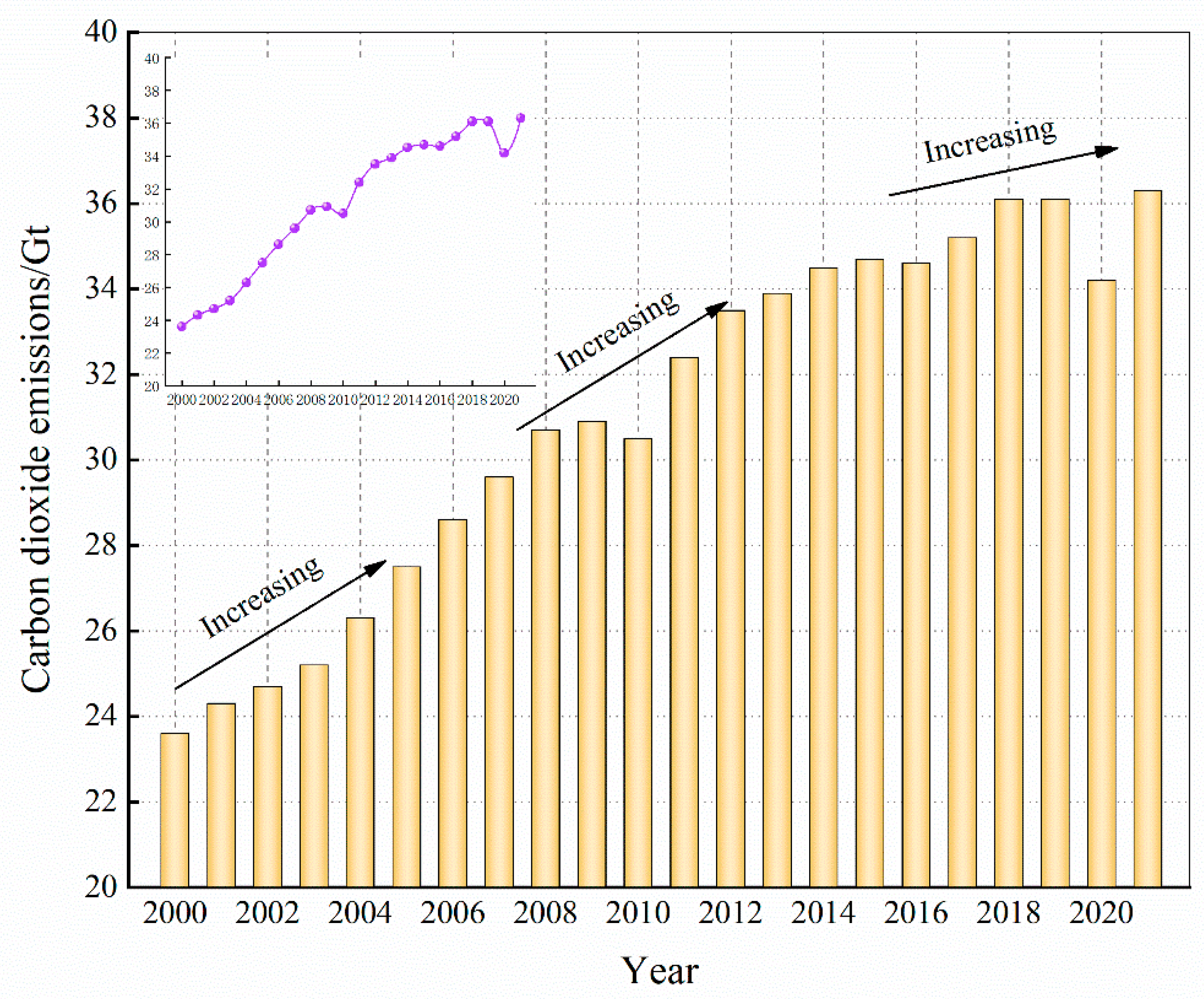
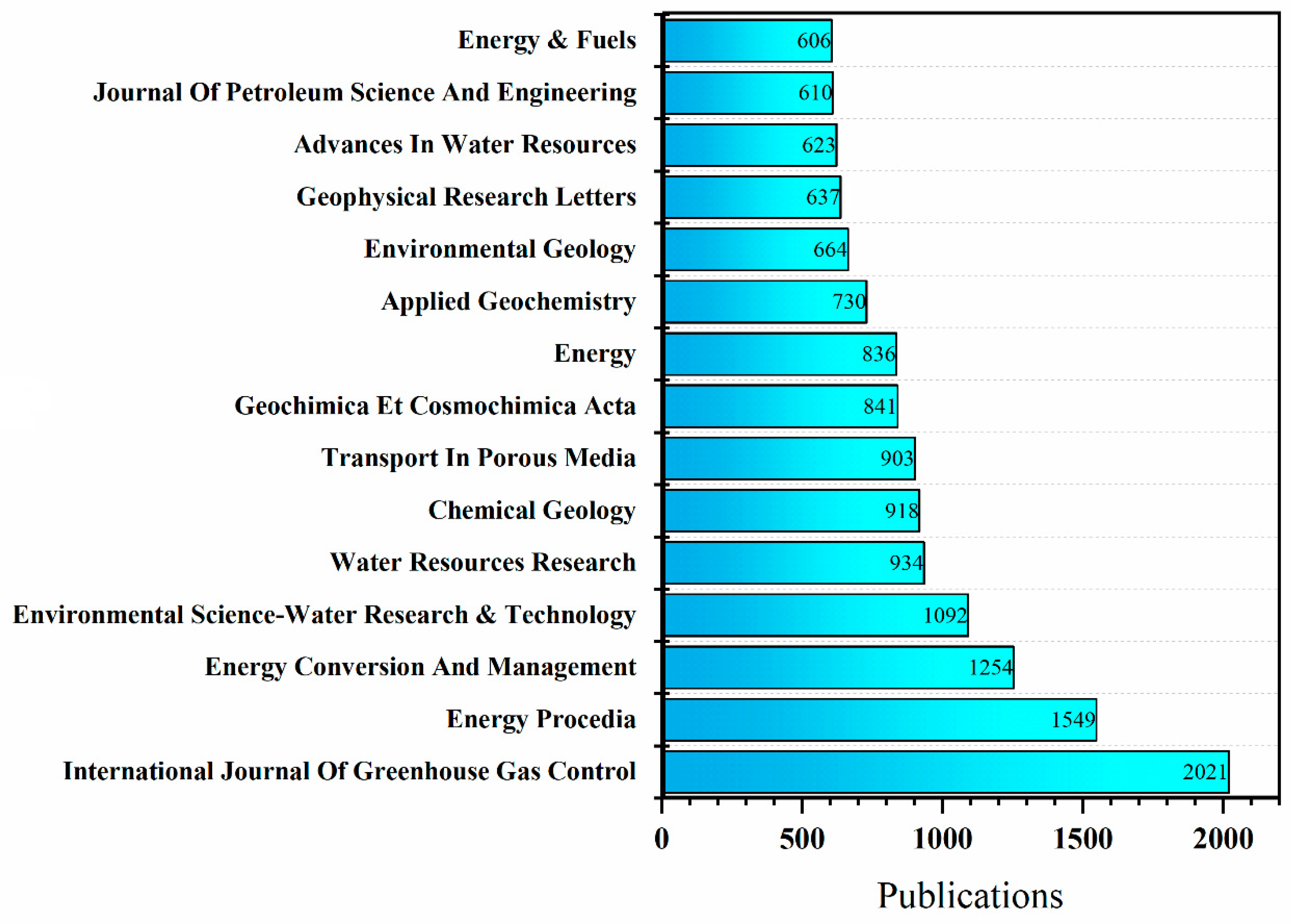
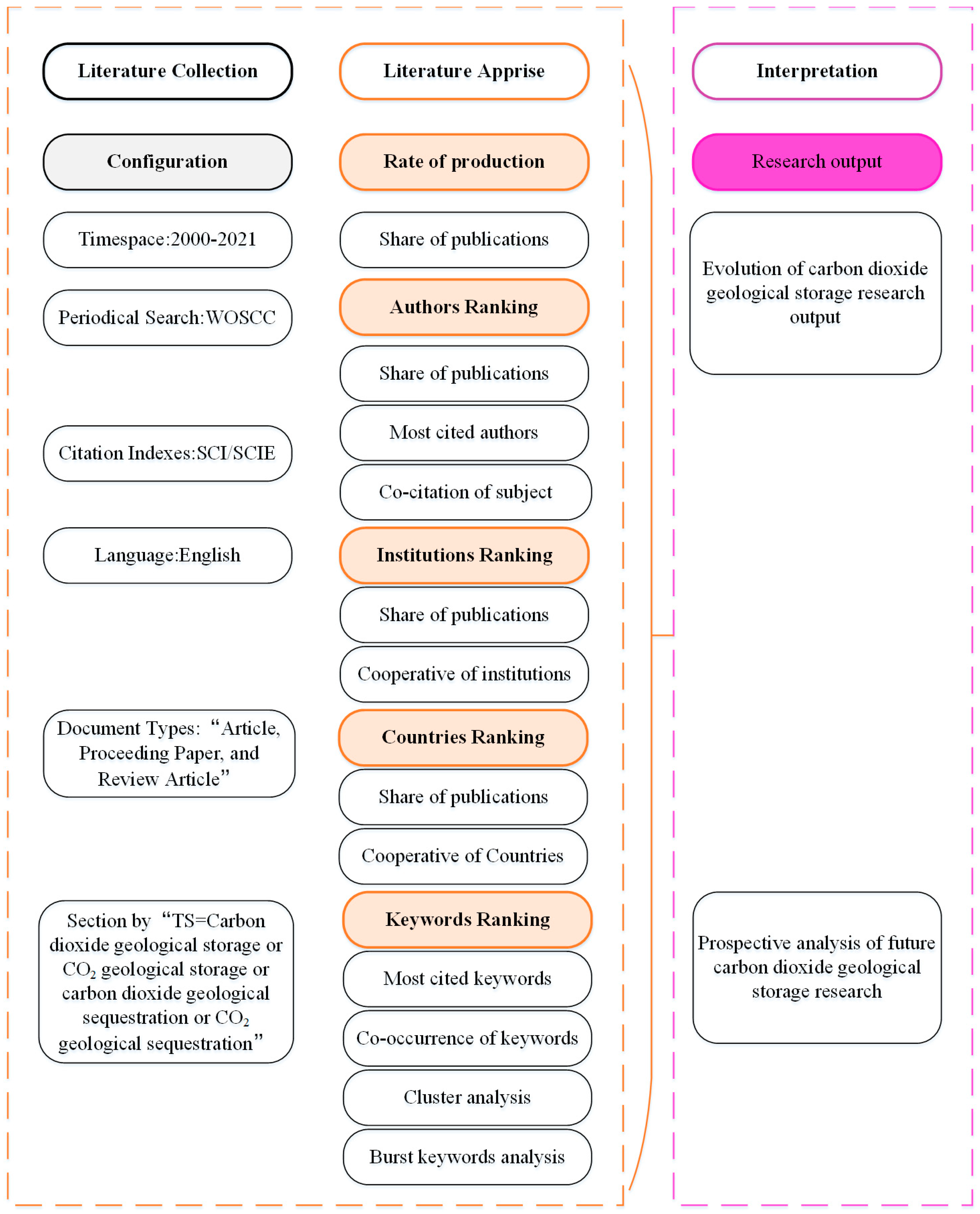

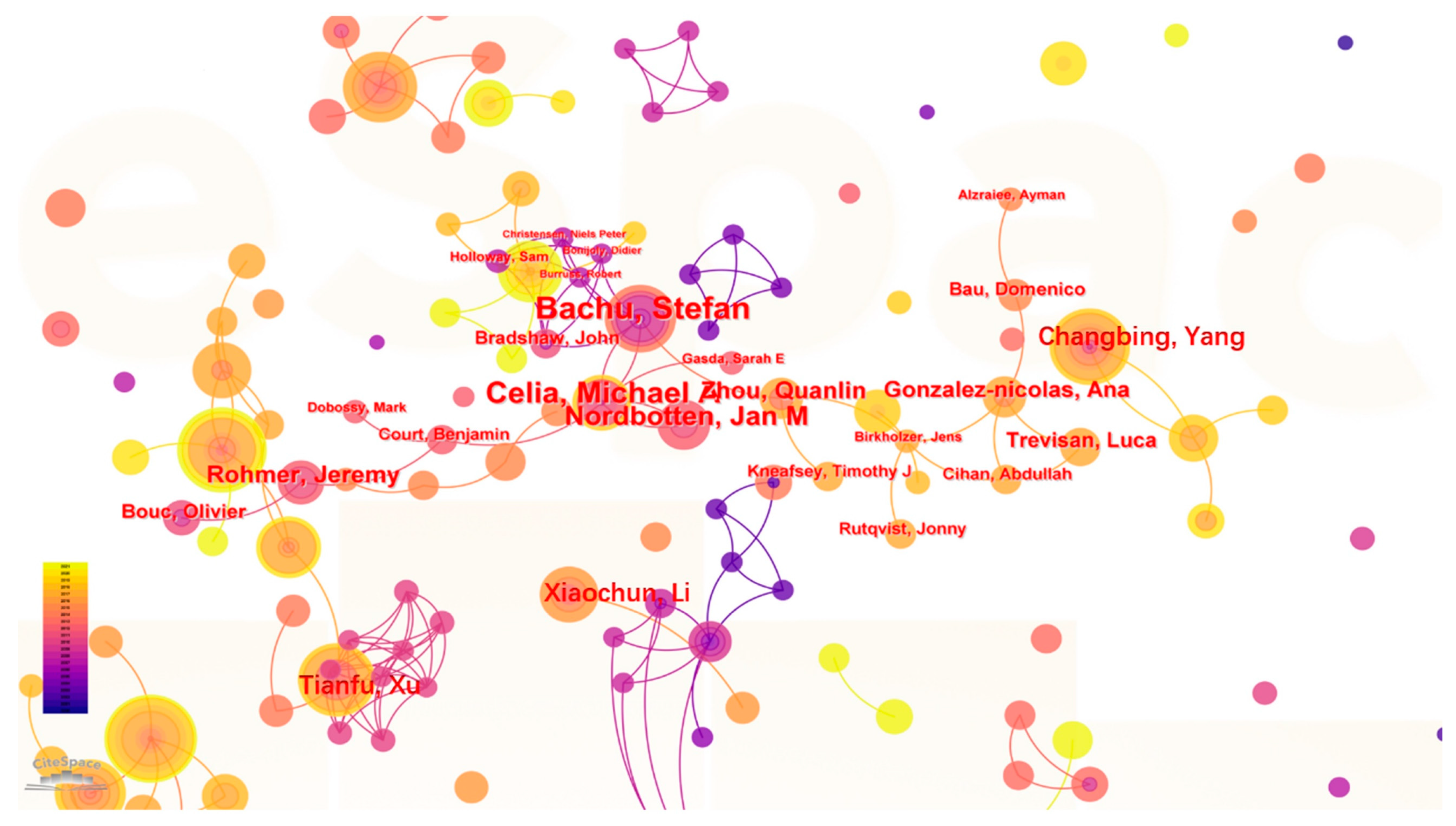

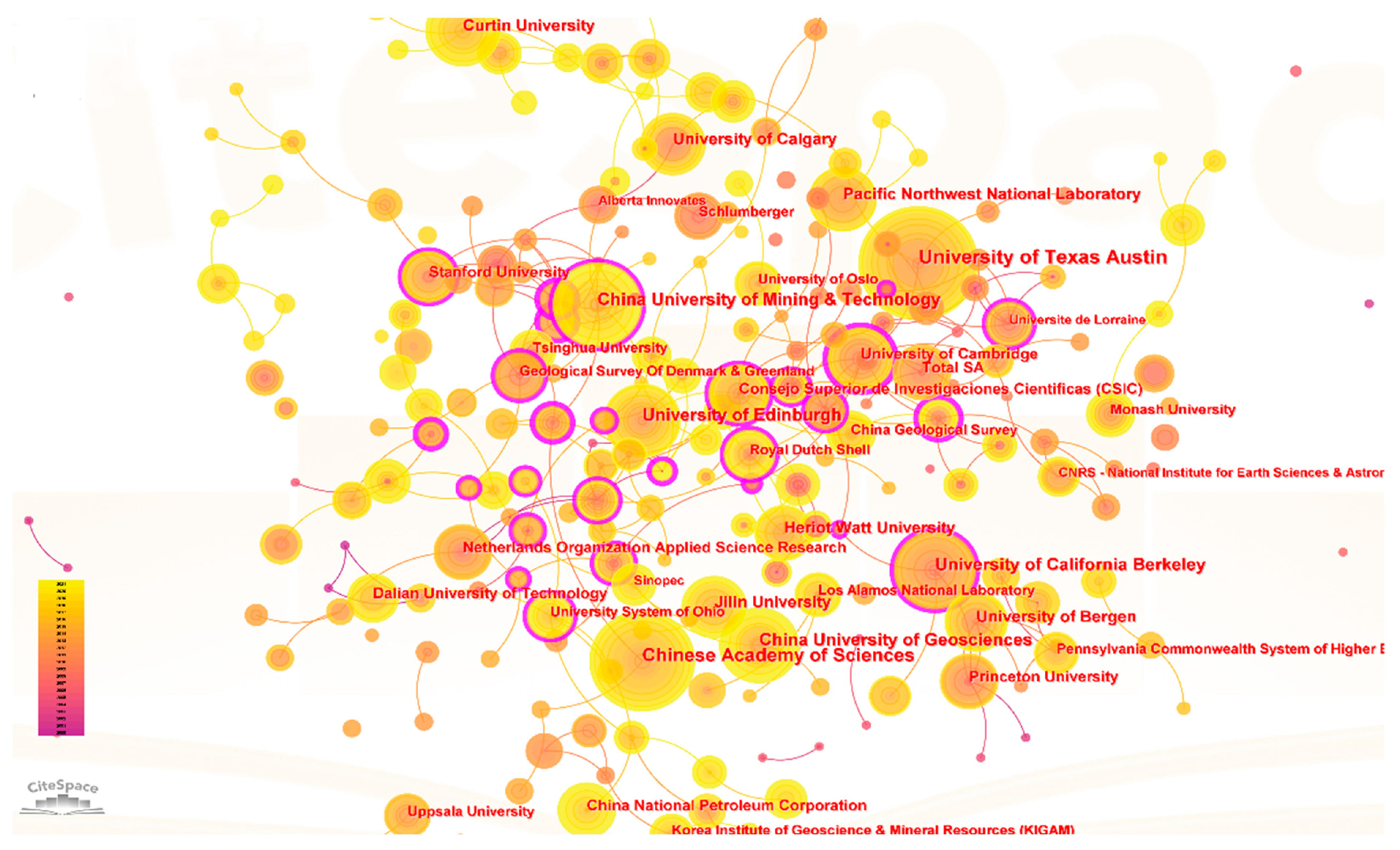
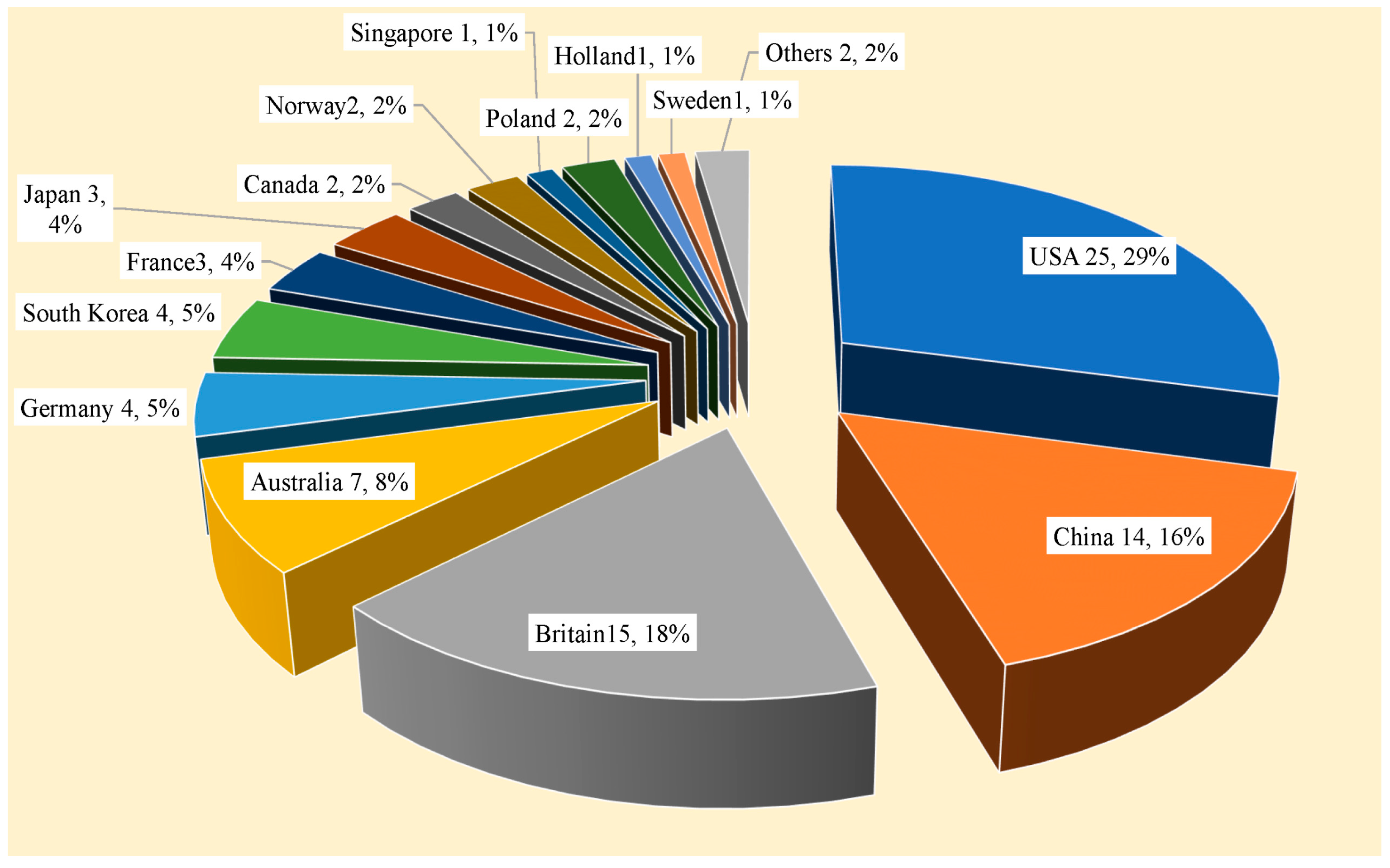
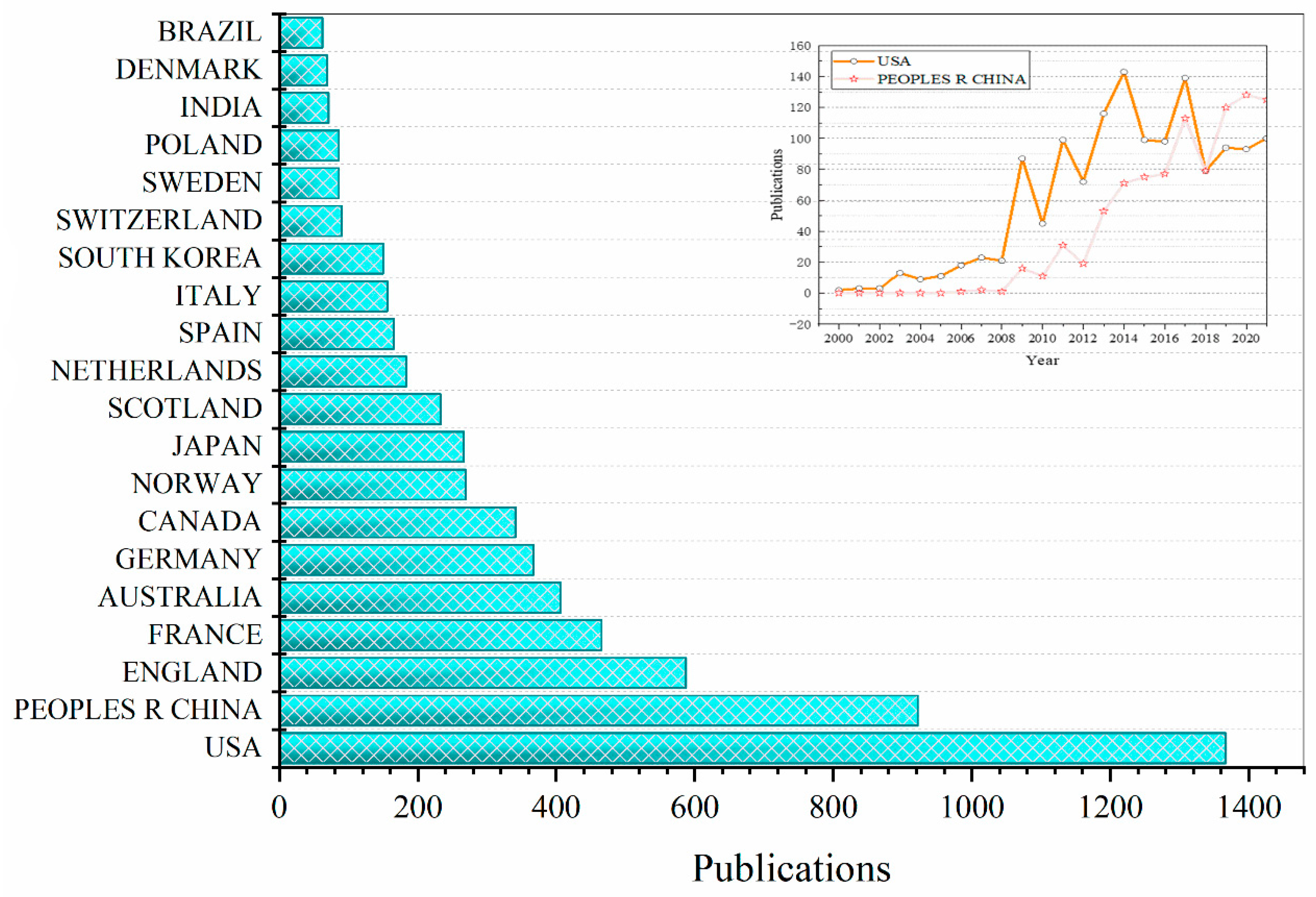
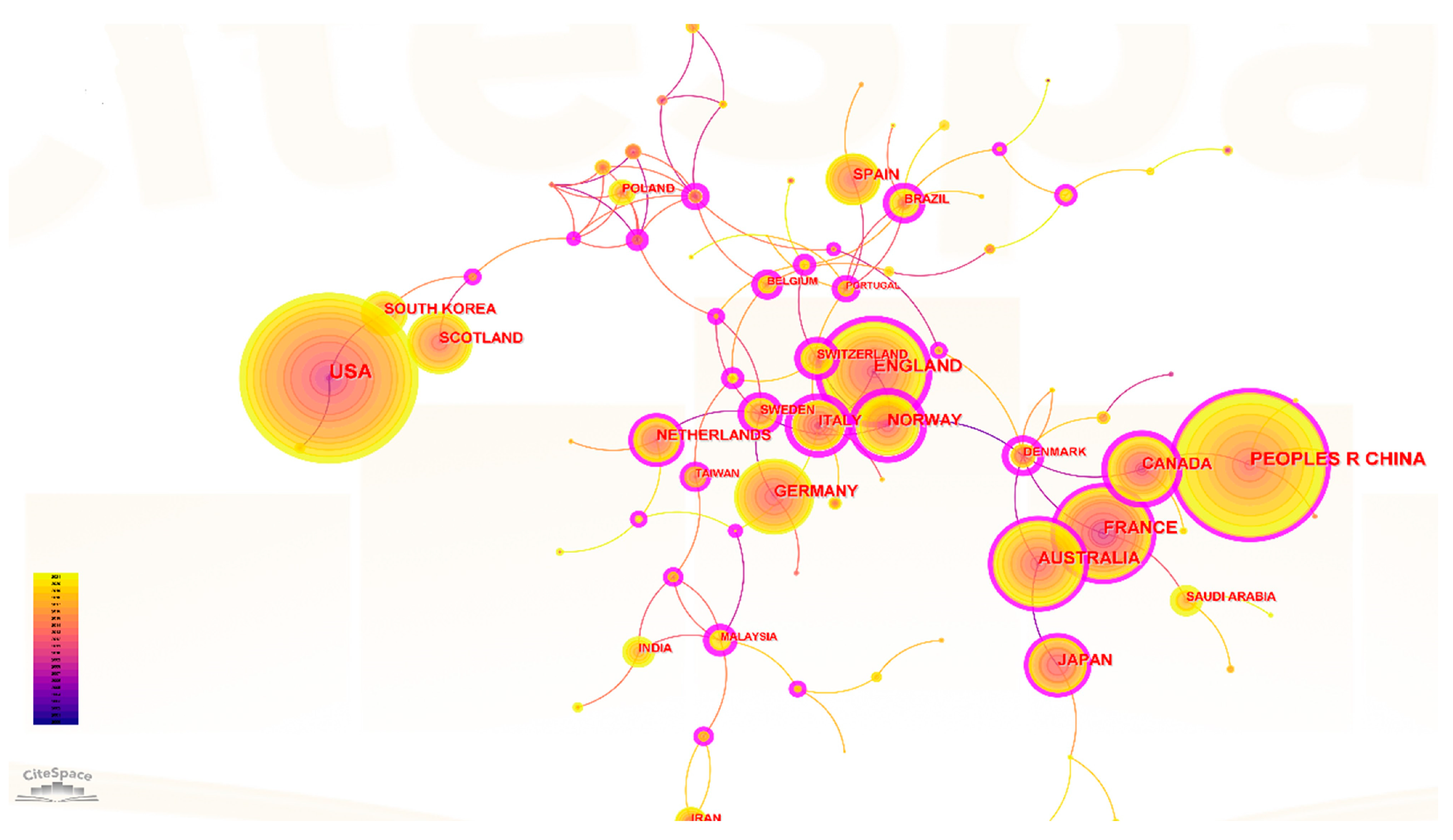
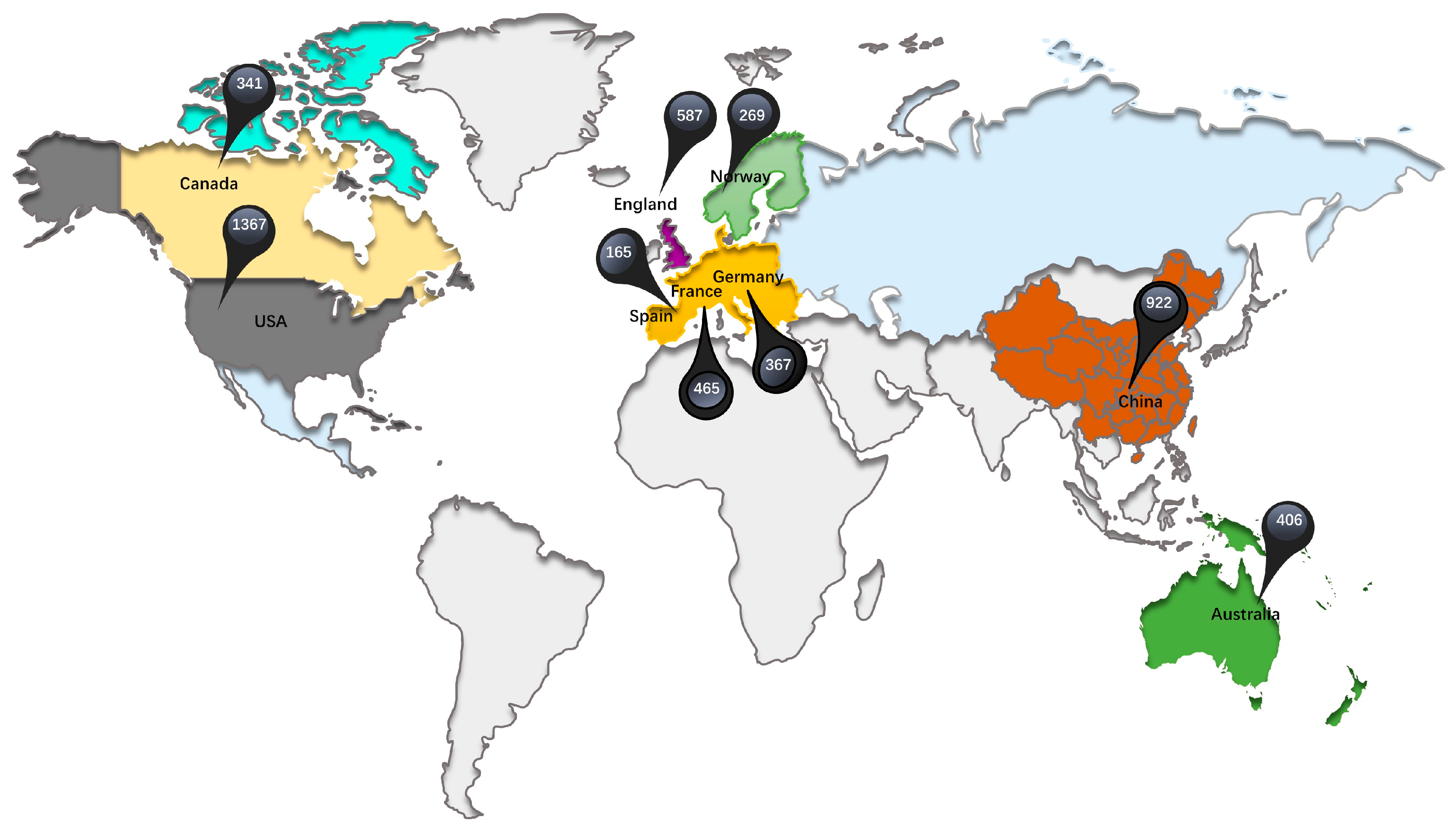
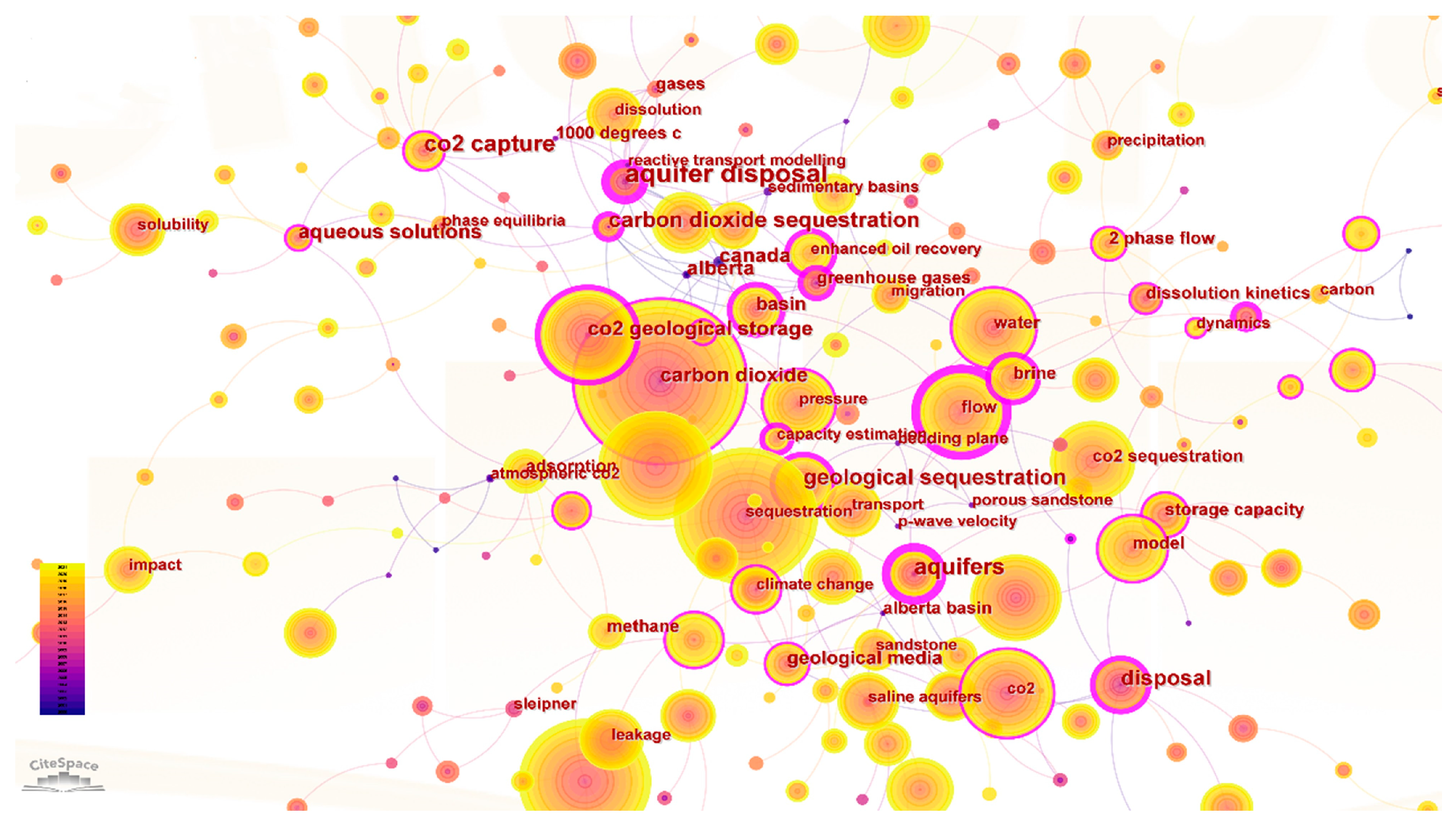
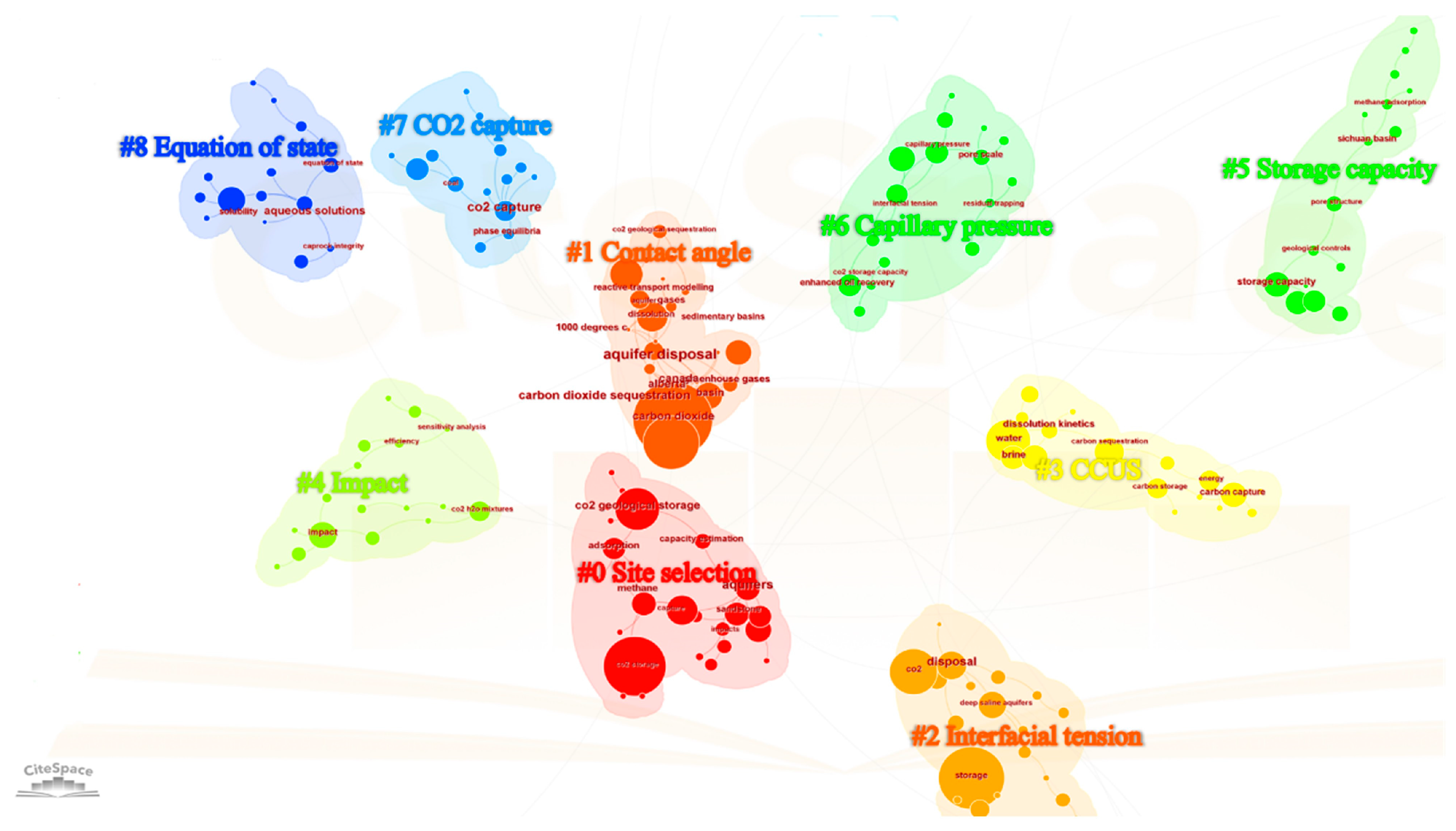

| Serial Number | Publications | Centrality | Author |
|---|---|---|---|
| 1 | 45 | 0 | Tianfu, Xu |
| 2 | 36 | 0 | Xiaochun, Li |
| 3 | 34 | 0 | Qi, Li |
| 4 | 30 | 0 | Yongchen, Song |
| 5 | 29 | 0 | Ziqiu, Xue |
| 6 | 23 | 0 | Kempka, Thomas |
| 7 | 23 | 0.01 | Bachu, Stefan |
| 8 | 21 | 0 | Iglauer, Stefan |
| 9 | 20 | 0 | Lanlan, Jiang |
| 10 | 18 | 0.01 | Celia, Michael A |
| 11 | 16 | 0 | Niemi, Auli |
| 12 | 16 | 0 | Yu, Liu |
| 13 | 14 | 0 | Bryant, Steven L |
| 14 | 14 | 0 | Bachu, S |
| 15 | 13 | 0 | Shariatipour, Seyed M |
| Serial Number | Publications | Centrality | Institution | Country |
|---|---|---|---|---|
| 1 | 419 | 0.29 | Univ Texas Austin | America |
| 2 | 208 | 0 | Chinese Acad Sci | China |
| 3 | 201 | 0.22 | Univ Calif Berkeley | America |
| 4 | 170 | 0.06 | Univ Edinburgh | Britain |
| 5 | 169 | 0.49 | China Univ Min & Technol | China |
| 6 | 169 | 0.46 | British Geol Survey | Britain |
| 7 | 149 | 0.13 | Univ Calgary | Canada |
| 8 | 142 | 0.46 | Jilin Univ | China |
| 9 | 128 | 0.31 | Univ Bergen | Norway |
| 10 | 126 | 0.1 | China Univ Geosci | China |
| 11 | 125 | 0.23 | Pacific NW Natl Lab | America |
| 12 | 124 | 0.09 | Heriot Watt Univ | Britain |
| 13 | 124 | 0.11 | Curtin Univ | Singapore |
| 14 | 124 | 0.05 | Univ Cambridge | America |
| 15 | 104 | 0.05 | China Univ Petr | China |
| 16 | 103 | 0.05 | Stanford Univ | America |
| 17 | 99 | 0.02 | Princeton Univ | America |
| 18 | 99 | 0.17 | China Univ Petr East China | China |
| 19 | 97 | 0 | Lawrence Berkeley Natl Lab | America |
| 20 | 96 | 0 | Uppsala Univ | Sweden |
Disclaimer/Publisher’s Note: The statements, opinions and data contained in all publications are solely those of the individual author(s) and contributor(s) and not of MDPI and/or the editor(s). MDPI and/or the editor(s) disclaim responsibility for any injury to people or property resulting from any ideas, methods, instructions or products referred to in the content. |
© 2024 by the authors. Licensee MDPI, Basel, Switzerland. This article is an open access article distributed under the terms and conditions of the Creative Commons Attribution (CC BY) license (https://creativecommons.org/licenses/by/4.0/).
Share and Cite
Wang, F.; Wang, G.; Wang, H.; Niu, H.; Chen, Y.; Li, X.; Niu, G. Analysis of the Current Status and Hot Technologies of Carbon Dioxide Geological Storage. Processes 2024, 12, 1347. https://doi.org/10.3390/pr12071347
Wang F, Wang G, Wang H, Niu H, Chen Y, Li X, Niu G. Analysis of the Current Status and Hot Technologies of Carbon Dioxide Geological Storage. Processes. 2024; 12(7):1347. https://doi.org/10.3390/pr12071347
Chicago/Turabian StyleWang, Feiran, Gongda Wang, Haiyan Wang, Huiyong Niu, Yue Chen, Xiaoxuan Li, and Guchen Niu. 2024. "Analysis of the Current Status and Hot Technologies of Carbon Dioxide Geological Storage" Processes 12, no. 7: 1347. https://doi.org/10.3390/pr12071347






